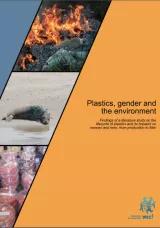Plastics, gender and the environment
Findings of a literature study on the lifecycle of plastics and its impacts on woman and men, from production to litter.
Product details
Table of contents
- Executive summary
- Main findings from the literature study
- The report
- Table of Contents
- Tables, figures and boxes
- Abbreviations
- Introduction - The nexus of gender and plastic
1. Understanding the overall dimensions of gender in plastic production and consumption
2. Workforce and exposure in the plastic industry
- 2.1 Socially determined factors of the workforce
- 2.2 Physiological differences between women and men often incompatible labour protection policies
- 2.3 Worker´s exposure to hazardous chemicals
3. Overview of hazardous chemicals in plastics and their impact on women´s and men´s health
- 3.1 Plastics, EDCs and observed healtheffects
4. Exposure to hazardous chemicals from some everyday products
5. Gender and microplastics management
- 5.1 Background
- 5.2 Products that contain microplastics and the role of men and women in production consumption
- 5.3 Microplastics in the environment and its sources
- 5.4 Can we manage microplastics in the environment – and what is the role for men/women as agent of change?
6. Marine environment: Exposure to (micro-) plastics and health aspects for aquatic organisms
- 6.1 Occurrence and pathways of (micro-) plastics in the marine environment
- 6.2 Uptake of plastic particles and transfer between trophic levels
- 6.3 Plastic uptake and accumulation in animals
- 6.4 Seafood and gender aspects
- 6.5 Fishing related marine litter and gender
7. Plastic waste management
- 7.1 Municipal solid waste generation
- 7.2 Plastic Recovery rates
- 7.3 Collecting and Recycling practices
- 7.4 Landfills and dumping; controlled and uncontrolled
- 7.5 Incineration: controlled and uncontrolled
8. Green consumerism, environmental awareness and behaviour
- 8.1 Social determinants and plastic exposure
- 8.2 Gender roles in waste generation and management
- 8.3 Factors influencing pro-environmental behavior and attitudes
9. Wastewater
- 9.1 Microplastics in wastewater
- 9.2 Personal Hygiene and wastewater: Gender aspects
10. Bio-plastics and classification of plastic waste
- 10.1 Bio degradable and bio-based plastics
- 10.2 Classification of plastic waste
11. Main findings from the Literature review
12. Recommendations
13. Women and men as agents of change
- Annex 1
- Bibliography
